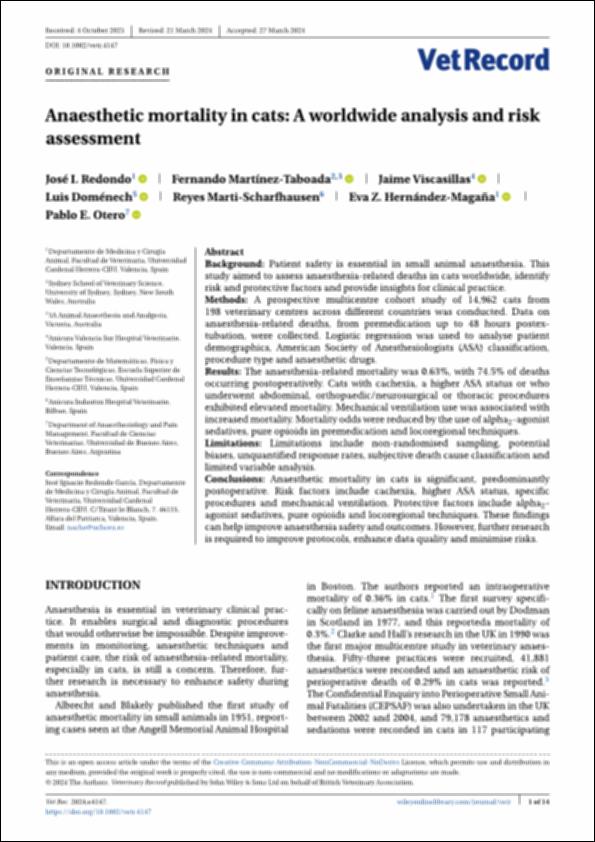Por favor, use este identificador para citar o enlazar este ítem:
http://hdl.handle.net/10637/16050Anaesthetic mortality in cats: a worldwide analysis and risk assessment
| Título : | Anaesthetic mortality in cats: a worldwide analysis and risk assessment |
| Autor : | Redondo García, José Ignacio Martínez Taboada, Fernando Viscasillas Monteagudo, Jaime Doménech Ballester, Luis Martí-Scharfhausen Sánchez, María de los Reyes Hernández Magaña, Eva Zoe Otero, Pablo E. |
| Materias: | Anestesia veterinaria; Veterinary anesthesia; Gatos; Cats; Mortalidad; Mortality |
| Editorial : | John Wiley & Sons |
| Citación : | Redondo, J.I., Martínez-Taboada, F., Viscasillas, J., Doménech, L., Marti-Scharfhausen, R., Hernández-Magaña, E.Z. & Otero, P.E. (2024). Anaesthetic mortality in cats: a worldwide analysis and risk assessment. The Veterinary Record, vol. 195, i. 1, art. e4147 (06 jul.). DOI: https://doi.org/10.1002/vetr.4147 |
| Resumen : | Background: Patient safety is essential in small animal anaesthesia. Thisstudy aimed to assess anaesthesia-related deaths in cats worldwide, identifyrisk and protective factors and provide insights for clinical practice.Methods: A prospective multicentre cohort study of 14,962 cats from198 veterinary centres across different countries was conducted. Data onanaesthesia-related deaths, from premedication up to 48 hours postex-tubation, were collected. Logistic regression was used to analyse patientdemographics, American Society of Anesthesiologists (ASA) classification,procedure type and anaesthetic drugs.Results: The anaesthesia-related mortality was 0.63%, with 74.5% of deathsoccurring postoperatively. Cats with cachexia, a higher ASA status or whounderwent abdominal, orthopaedic/neurosurgical or thoracic proceduresexhibited elevated mortality. Mechanical ventilation use was associated withincreased mortality. Mortality odds were reduced by the use of alpha2 -agonistsedatives, pure opioids in premedication and locoregional techniques.Limitations: Limitations include non-randomised sampling, potentialbiases, unquantified response rates, subjective death cause classification andlimited variable analysis.Conclusions: Anaesthetic mortality in cats is significant, predominantlypostoperative. Risk factors include cachexia, higher ASA status, specificprocedures and mechanical ventilation. Protective factors include alpha2 -agonist sedatives, pure opioids and locoregional techniques. These findingscan help improve anaesthesia safety and outcomes. However, further researchis required to improve protocols, enhance data quality and minimise risks. |
| URI : | http://hdl.handle.net/10637/16050 |
| Derechos: | http://creativecommons.org/licenses/by-nc-nd/4.0/deed.es Open Access |
| ISSN : | 0042-4900 2042-7670 (Electrónico) |
| Cubierto por: | Acuerdo Transformativo – 2024 |
| Fecha de publicación : | 6-jul-2024 |
| Centro : | Universidad Cardenal Herrera-CEU |
| Aparece en las colecciones: | Dpto. Medicina y Cirugía Animal |
Los ítems de DSpace están protegidos por copyright, con todos los derechos reservados, a menos que se indique lo contrario.


